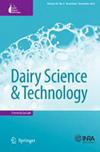The Impact of Low-Temperature Inactivation of Protease AprX from Pseudomonas on Its Proteolytic Capacity and Specificity: A Peptidomic Study
Q2 Agricultural and Biological Sciences
引用次数: 0
Abstract
The destabilization of UHT milk during its shelf life can be promoted by the residual proteolytic activity attributed to the protease AprX from Pseudomonas. To better understand the hydrolysis patterns of AprX, and to evaluate the feasibility of using low-temperature inactivation (LTI) for AprX, the release of peptides through AprX activity on milk proteins was examined using an LC-MS/MS-based peptidomic analysis. Milk samples were either directly incubated to be hydrolyzed by AprX, or preheated under LTI conditions (60 °C for 15 min) and then incubated. Peptides and parent proteins (the proteins from which the peptides originated) were identified and quantified. The peptides were mapped and the cleavage frequency of amino acids in the P1/P1′ positions was analyzed, after which the influence of LTI and the potential bitterness of the formed peptides were determined. Our results showed that a total of 2488 peptides were identified from 48 parent proteins, with the most abundant peptides originating from κ-casein and β-casein. AprX may also non-specifically hydrolyze other proteins in milk. Except for decreasing the bitterness potential in skim UHT milk, LTI did not significantly reduce the AprX-induced hydrolysis of milk proteins. Therefore, the inactivation of AprX by LTI may not be feasible in UHT milk production.假单胞菌AprX蛋白酶低温失活对其蛋白水解能力和特异性的影响:肽组学研究
假单胞菌AprX蛋白酶残留的蛋白水解活性可促进UHT牛奶在保质期内的不稳定。为了更好地了解AprX的水解模式,并评估低温失活(LTI)对AprX的可行性,使用LC-MS/MS-based肽组学分析检测了AprX在乳蛋白上的活性对肽的释放。牛奶样品要么直接孵育,用AprX水解,要么在LTI条件下预热(60°C 15 min),然后孵育。多肽和亲本蛋白(多肽来源的蛋白)被鉴定和定量。绘制多肽图谱,分析P1/P1 '位置氨基酸的切割频率,然后确定LTI和形成的多肽的潜在苦味的影响。结果表明,从48个亲本蛋白中共鉴定出2488个多肽,其中以κ-酪蛋白和β-酪蛋白的多肽含量最多。AprX也可能非特异性水解牛奶中的其他蛋白质。除了降低脱脂UHT牛奶的苦味潜力外,LTI没有显著降低aprx诱导的牛奶蛋白水解。因此,LTI对AprX的失活在UHT牛奶生产中可能是不可行的。
本文章由计算机程序翻译,如有差异,请以英文原文为准。
求助全文
约1分钟内获得全文
求助全文
来源期刊

Dairy Science & Technology
农林科学-食品科技
CiteScore
2.30
自引率
0.00%
发文量
0
审稿时长
2 months
期刊介绍:
Information not localized
 求助内容:
求助内容: 应助结果提醒方式:
应助结果提醒方式:


